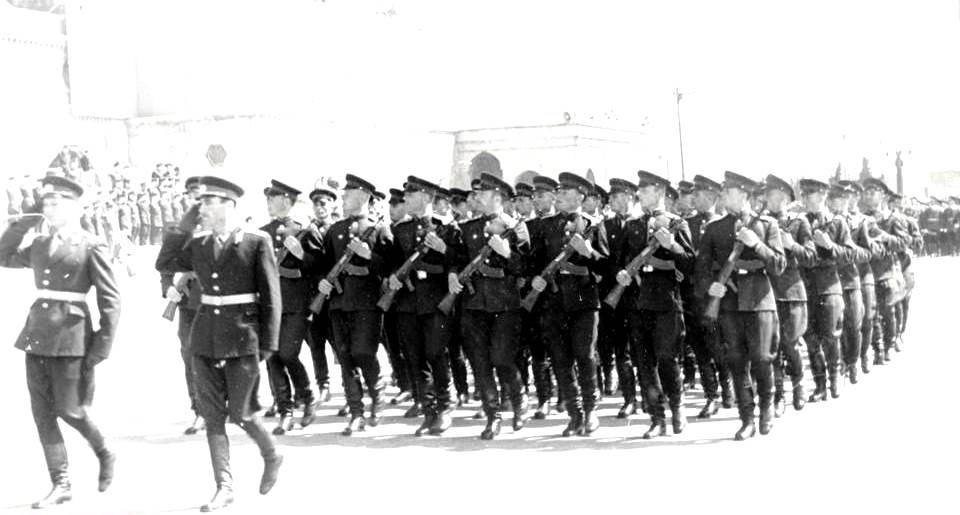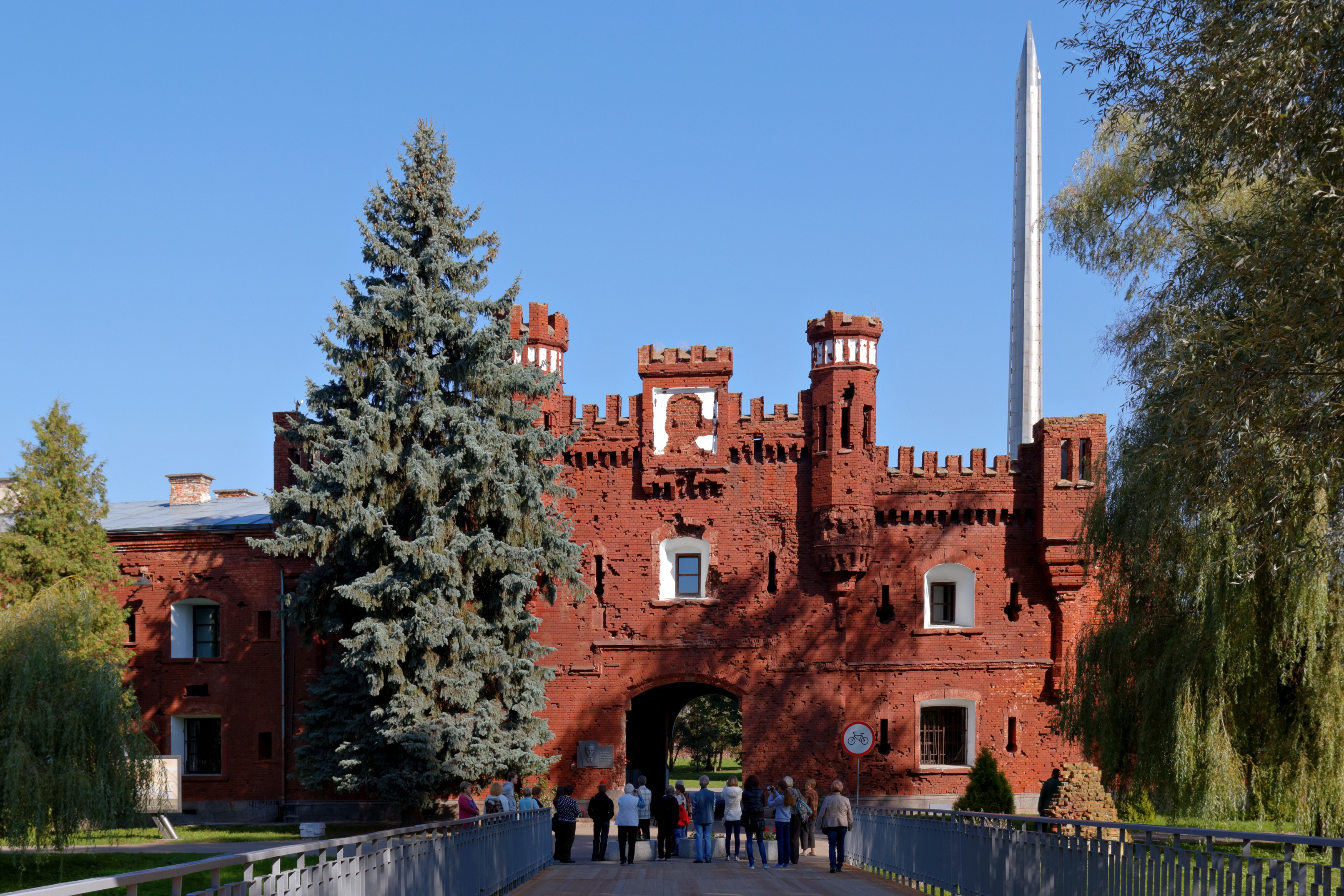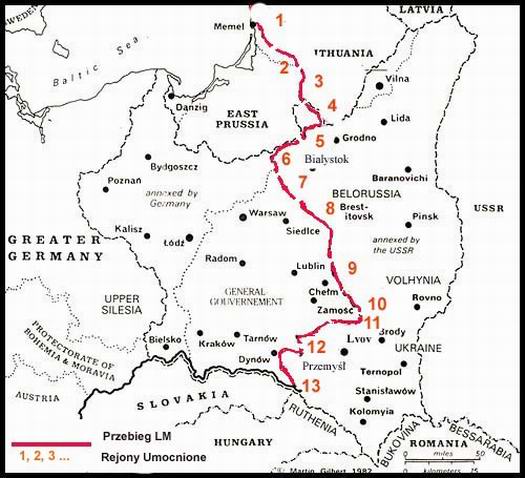|
Fourth Army (Soviet Union)
The 4th Army was a Soviet field army of World War II that served on the Eastern front of World War II and in the Caucasus during the Cold War. It was disbanded after the fall of the Soviet Union, with its divisions being withdrawn to Russia and disbanded. World War II First Formation The Fourth Army was created in August 1939 in the Belorussian Special Military District from the Bobruisk Army Group as an independent army. In September 1939, the Fourth Army took part in the Soviet invasion of Poland commanded by the future Marshal of Soviet Union V.I. Chuykov, the defender of Stalingrad. Its order of battle in that operation is listed here. Elements of the army, apparently 4th Battalion, 29th Light Tank Brigade, took part in the German–Soviet military parade in Brest-Litovsk on September 22, 1939. When the German invasion of the Soviet Union commenced on 22 June 1941, the Army was part of the Western Front and had the 28th Rifle Corps ( 6th Rifle Division and 42nd Rifle Di ... [...More Info...] [...Related Items...] OR: [Wikipedia] [Google] [Baidu] |
Transcaucasian Military District
The Transcaucasian Military District, a military district of the Soviet Armed Forces, traces its history to May 1921 and the incorporation of Armenia, Azerbaijan, and Georgia into the Soviet Union. It was disbanded by being redesignated as a Group of Forces in the early 1990s after the Soviet Union collapse. The military district formed as a basis of the modern day armed forces of Armenia, Azerbaijan, and Georgia as well as unrecognized polities of Abkhazia, the Republic of Artsakh and South Ossetia. History The Transcaucasian Military District was originally formed from the Red Army's Separate Caucasian Army, which became the Red Banner Caucasian Army in August 1923. On 17 May 1935, the Red Banner Caucasus Army was redesignated the Transcaucasian Military District. The Georgian, Armenian, and Azerbaijani national formations, plus units from the 11th Soviet Red Army, all joined the new district about this time. In July 1936 the District's formations and units received designat ... [...More Info...] [...Related Items...] OR: [Wikipedia] [Google] [Baidu] |
42nd Motor Rifle Division
The 42nd Guards "Evpatoriyskaya Red Banner" Motor Rifle Division (Military Unit Number 27777, until 1987 MUN 29410; until 2009 MUN 28320)Michael Holm42nd Guards Training Motor Rifle Division accessed February 2015. is a Russian military unit. The division was formed originally as the 111th Rifle Division in Vologda in 1940, and became the 24th Guards Rifle Division in March 1942. It was based in the North Caucasus following World War II; it became 42nd Guards MRD on 10 June 1957, while at Grozny. It became 42nd Guards Training Motor Rifle Division, part of the 12th Army Corps, on 18 October 1960. Second World War The division was formed in July 1940 in Vologda as the 111th Rifle Division on the basis of the 29th Reserve Brigade of the Arkhangelsk Military District. In the active army from June 22, 1941 to March 17, 1942. On July 16, 1940, the division was fully formed (which became the division's anniversary). Until March 1941, the 111th Rifle Division only held 3,000 personne ... [...More Info...] [...Related Items...] OR: [Wikipedia] [Google] [Baidu] |
Brest Fortress
Brest Fortress ( be, Брэсцкая крэпасць, '; pl, Twierdza brzeska, russian: Брестская крепость), formerly known as Brest-Litoŭsk Fortress, is a 19th-century fortress in Brest, Belarus. In 1965, the title "Hero Fortress" was given to the fortress to commemorate the defence of the frontier stronghold during the first week of the Operation Barbarossa when Axis forces invaded the Soviet Union on June 22, 1941. The title "Hero Fortress" corresponds to the title " Hero City" that the Presidium of the Supreme Soviet of the Soviet Union awarded to twelve Soviet cities. Description The Brest fortress has sustained its original outline of a star shaped fortification since its construction in the early 19th century. The Citadel, the core of the fortress, was on the central island formed by the Bug River and the two branches of the Mukhavets River. The island was skirted by a ring of a two-storied barrack with 4 semi-towers. The 1.8 km long b ... [...More Info...] [...Related Items...] OR: [Wikipedia] [Google] [Baidu] |
Stepan Oborin
Stepan Ilyich Oborin (; 15 August 1892 – 16 October 1941) was a Red Army major general. Oborin served as a gunner in the Imperial Russian Army in World War I and subsequently joined the Red Army. He fought in the Russian Civil War and became an artillery officer. He led the artillery of the 19th Rifle Corps in the Winter War. After the end of the war he became commander of the 136th Rifle Division and then the 14th Mechanized Corps. The corps was destroyed in the Battle of Białystok–Minsk after the German invasion of the Soviet Union. Oborin was wounded during the battle and flew back to Moscow for treatment. He was arrested for desertion, sentenced to death and shot on 16 October 1941. Oborin was posthumously rehabilitated in 1957. Early life, World War I, and Russian Civil War Oborin was born on 15 August 1892 in the village of Kamenka in Tver Governorate to a working-class family. He graduated from the parish school in 1903 and became a textile worker. In October 191 ... [...More Info...] [...Related Items...] OR: [Wikipedia] [Google] [Baidu] |
Panzer Group 2
The 2nd Panzer Army (german: 2. Panzerarmee) was a German armoured formation during World War II, formed from the 2nd Panzer Group on October 5, 1941. Organisation Panzer Group Guderian (german: Panzergruppe Guderian) was formed on 5 June 1940 and named after its commander, general Heinz Guderian. In early June 1940, after reaching the English Channel following the breakthrough in the Ardennes, the ''Panzergruppe Guderian'' was formed from the XIX Army Corps, and thrust deep into France, cutting off the Maginot Line. In November 1940, it was upgraded into ''Panzergruppe 2''. The 2nd Panzer Group (german: Panzergruppe 2) was formed in November 1940 from Panzer Group Guderian. In October 1941 it was renamed the 2nd Panzer Army. Panzer Group 2 played a significant role in the early stages of the German invasion of the Soviet Union during Operation Barbarossa in 1941 when it was a constituent part of Army Group Centre. Operational history 2nd Panzer Group was part of the Army ... [...More Info...] [...Related Items...] OR: [Wikipedia] [Google] [Baidu] |
4th Army (Wehrmacht)
The 4th Army () was a field army of the Wehrmacht during World War II. Invasions of Poland and France The 4th Army was activated on 1 August 1939 with General Günther von Kluge in command. It took part in the Invasion of Poland of September 1939 as part of Army Group North, which was under Field Marshal Feodor von Bock. The 4th Army contained the II Corps and III Corps, each with two infantry divisions, the XIX Corps with two motorized and one panzer divisions, and three other divisions, including two in reserve. Its objective was to capture the Polish Corridor, thus linking mainland Germany with East Prussia. During the attack on the Low Countries and France, the 4th Army, as part of Field Marshal Gerd von Rundstedt's Army Group A, invaded Belgium from the Rhineland. Along with other German armies, the 4th Army penetrated the Dyle Line and completed the trapping of the Allied forces in France. The then Major-General Erwin Rommel, who was under Kluge, contributed immensely ... [...More Info...] [...Related Items...] OR: [Wikipedia] [Google] [Baidu] |
Bug River
uk, Західний Буг be, Захо́дні Буг , name_etymology = , image = Wyszkow_Bug.jpg , image_size = 250 , image_caption = Bug River in the vicinity of Wyszków, Poland , map = Vistula river map.png , map_size = 250px , map_caption = Bug River through Ukraine, Belarus and Poland , pushpin_map = , pushpin_map_size = 250px , pushpin_map_caption= , subdivision_type1 = Country , subdivision_name1 = Poland, Belarus, Ukraine , subdivision_type2 = , subdivision_name2 = , subdivision_type3 = VoivodeshipVoblastOblast , subdivision_name3 = Podlaskie, Mazovian, Lublin, Brest, Lviv , subdivision_type4 = , subdivision_name4 = , subdivision_type5 = , subdivision_name5 = , length = , width_min = , width_avg = , width_max = , depth_min = , depth_avg = , depth_max = , discharge1_location= Se ... [...More Info...] [...Related Items...] OR: [Wikipedia] [Google] [Baidu] |
John Erickson (historian)
John Erickson, FRSE, FBA, FRSA (17 April 1929 – 10 February 2002) was a British historian and defence expert who wrote extensively on the Second World War. His two best-known books – ''The Road to Stalingrad'' and ''The Road to Berlin'' – dealt with the Soviet response to the German invasion of the Soviet Union, covering the period from 1941 to 1945. He was respected for his knowledge of the Soviet Union during the Cold War. His Russian language skills and knowledge gained him respect. Education and career John Erickson was born on 17 April 1929 in the town of South Shields (then part of County Durham), England. He was educated at South Shields High School for Boys and St John's College, Cambridge, where he graduated MA Hons. He became a research fellow of St Antony's College, Oxford, from 1956 until 1958, during which he met his future wife Ljubica Petrovic, a young Yugoslavian attending Oxford to read English. At the culmination of their courtship, they sought the ... [...More Info...] [...Related Items...] OR: [Wikipedia] [Google] [Baidu] |
Kobrin
Kobryn ( be, Кобрын; russian: Кобрин; pl, Kobryń; lt, Kobrynas; uk, Кобринь, Kobryn'; yi, קאָברין) is a city in the Brest Region of Belarus and the center of the Kobryn District. The city is located in the southwestern corner of Belarus, where the Mukhavets River and Dnepr-Bug Canal meet. The city lies about 52 km east of the city of Brest. Kobryn is located at Latitude 52.12.58N and Longitude 24.21.59E. It is at an altitude of 485 feet. It is a station on the Brest – Homiel railway line. As of 1995, the population was around 51,500. Sometimes the name of the city is written as ''Kobrin'' which is a transliteration from Russian. History In the early times, it was inhabited by the ancient Balts, Baltic Yotvingian tribe. At various times, the city belonged to Kingdom of Galicia–Volhynia, the Grand Duchy of Lithuania, the Polish–Lithuanian Commonwealth, the Russian Empire, the Second Polish Republic, the Byelorussian Soviet Socialist Republ ... [...More Info...] [...Related Items...] OR: [Wikipedia] [Google] [Baidu] |
Brest, Belarus
Brest ( be, Брэст / Берасьце, Bieraście, ; russian: Брест, ; uk, Берестя, Berestia; lt, Brasta; pl, Brześć; yi, בריסק, Brisk), formerly Brest-Litovsk (russian: Брест-Литовск, lit=Lithuanian Brest; be, links=no, translit=Berastze Litouski (Berastze), Берасце Літоўскі (Берасце); lt, links=no, Lietuvos Brasta; pl, links=no, Brześć Litewski, ), Brest-on-the-Bug ( pl, links=no, Brześć nad Bugiem), is a city (population 350,616 in 2019) in Belarus at the border with Poland opposite the Polish city of Terespol, where the Bug (river), Bug and Mukhavets rivers meet, making it a border town. It is the capital city of the Brest Region. Brest is a historical site for many cultures, as it hosted important historical events, such as the Union of Brest and Treaty of Brest-Litovsk. Furthermore, the Brest Fortress was recognized by the Soviet Union as a Hero Fortress in honour of the defense of Brest Fortress in Jun ... [...More Info...] [...Related Items...] OR: [Wikipedia] [Google] [Baidu] |
12th Rifle Division (Soviet Union)
The 12th Rifle Division was an infantry division of the Red Army, formed twice. The division's first formation fought in the Russian Civil War and Polish–Soviet War. It was disbanded in 1921. The division formed again in 1923 at Omsk and spent World War II in Siberia. It participated in the Soviet invasion of Manchuria and was converted into a motor rifle division in 1957. History First formation The division was formed on 22 October 1918 from the 1st Voronezh Infantry Division. It fought on the Southern Front of the Russian Civil War. In December 1919, it fought in the Donbass Operation as part of the 1st Cavalry Army. After fighting in the Kuban campaign in February and March 1920, the division was sent to the Western Front in April. Between May and August, it fought in the Polish–Soviet War, participating in the Battle of Warsaw. In November it transferred to Ukraine and fought against Symon Petliura's army. The division was given the honorific "on behalf of the ... [...More Info...] [...Related Items...] OR: [Wikipedia] [Google] [Baidu] |
Fortified Region
A fortified district or fortified region (russian: Укреплённый район, Укрепрайон, ukreplyonny raion, ukrepraion) in the military terminology of the Soviet Union, is a territory within which a complex system of defense fortifications was engineered. Each fortified district consisted of a large number of concrete bunkers (pillboxes) armed with machineguns, antitank guns and artillery. The bunkers were built in groups for mutual support, each group forming a centre of resistance. The area in between was filled with various barriers and obstacles, as well as mine fields. A dedicated military unit (Fortified district troops) was permanently assigned to man each region. The concept of ''ukrepraions'' was developed during the Russian Civil War, when large territories were to be defended by relatively sparse military force. The first military units named so appeared in 1923. In 1928 the program for the construction of the comprehensive system of fortified di ... [...More Info...] [...Related Items...] OR: [Wikipedia] [Google] [Baidu] |




.png)

